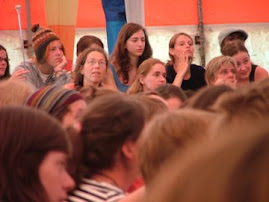Last December 9, Angan-Angan (Dreams) won the Mindanao Shorts in the Kontra-Agos film festival known for showing films that “go against the grain.” In an interview, Sheron Dayoc, the director, reveals Angan-Angan (Dreams) is really a story about the Yakan women of Basilan.
In the jungles of Basilan a grandmother is weaving. She tells her ten year old granddaughter to learn how to weave in order to appear attractive to men. But the girl seems to have other plans. In one poignant scene in Angan-Angan (Dreams), the girl is squatting outside a classroom longingly watching and listening to the students reciting after their teacher. Her father passes by, sees her, and is furious. “I don’t want you to be like your mother,” he says, and drags her home. A series of flashbacks show that the girl’s mother left her family to join the Bangsamoro Movement despite her husband’s disapproval. The girl remembers that day well and is now torn about what to do – get married or get an education? In the end, the girl decides to follow her dream.
“That’s the beauty of the film,” says Fernand Salinas, a Mindanaoan filmmaker based in Davao City. “The ending doesn’t reveal what exactly the girl decides. The girl only says, ‘I will follow my dream and leaves her father. It’s up to the audience to decide what she’s going to do.”
In Zamboanga City, Sheron Dayoc, the director of Angan-Angan (Dreams), sits down for a chat in Katribu, a compound of bars, restos, and coffee shops where disco lights and mist cover a stage decked with instruments. Puffing on one cigarette after another, Sheron raises his voice above the blaring hip hop music and reveals that there are seven other community films made by filmmakers from Mindanao. All were commissioned by the Local Governance Support Program in ARMM (LGSPA) to show the many positive changes happening in ARMM, a region that is associated with terrorists, violence, and poverty.
In September 2007, LGSPA sent the filmmakers to join Nick de Ocampo’s directing workshop. Sheron recalls, “For Nick, the script is the backbone of the film. But visuals bring life to the script.” Nick’s input on the use of space was also something Sheron appreciated. “I learned that a shot doesn’t have to be complicated,” he says. “What’s important is that the shot has to say something about the film. Each shot should advance to the next shot.”
In October 2007, LGSPA sent the filmmakers to a community development workshop in Zamboanga City where they worked with 30 selected residents of Tawitawi, Sulu and Basilan in conceptualizing the scripts. Each group of 6 to 8 residents sat with a director and shared their life stories. Aside from this, the residents helped establish the setting. They described the tourist spots, the language used, the way people dress, their customs and beliefs. Of the Basilan residents, all except one were Yakan women; native settlers of Basilan. They shared stories of early marriages, and having to weave yet wanting to go to school.
For centuries, Yakans have been marrying off their young children who, after the elaborate ceremony, continue to live with their parents until they reach puberty. This gave Sheron the idea to film ten year old Satra on her wedding day. “Her father,” Sheron explains, “fears that if she gets an education, she will get Christianized and start having liberal ideas like equality between men and women.”
Sheron further explains that in the film, Satra’s mother is a Christian from Lamitan, Basilan who converted to Islam when she married a Muslim. The mother’s ability to read and write makes her intellectually superior to the father, and a source of inspiration to her daughter. When the mother is killed in a battle between the Bangsamoro and the military, the distraught father’s dislike for education grows. But before the dislike blows out of proportion, his mother tells him that she would have gone to school if she had the choice. She weaves not because she likes to, but because she doesn’t know anything else to do. The last scenes show Satra’s father arriving on her wedding day and giving her a paper with a drawing. For Sheron, this is the clincher. It signifies that the father is finally allowing his daughter to leave her marriage and go to school.
Indeed, Angan-Angan (Dreams) is full of symbolisms and viewers are often left to read between the lines. The message is crystal clear though: acceptance of new ideas takes time in Yakan culture but small steps have been taken by a few like Satra, her mother, grandmother, father, and the increasing number of Yakan women today who are in school and have even taken up influential positions in government.
In the jungles of Basilan a grandmother is weaving. She tells her ten year old granddaughter to learn how to weave in order to appear attractive to men. But the girl seems to have other plans. In one poignant scene in Angan-Angan (Dreams), the girl is squatting outside a classroom longingly watching and listening to the students reciting after their teacher. Her father passes by, sees her, and is furious. “I don’t want you to be like your mother,” he says, and drags her home. A series of flashbacks show that the girl’s mother left her family to join the Bangsamoro Movement despite her husband’s disapproval. The girl remembers that day well and is now torn about what to do – get married or get an education? In the end, the girl decides to follow her dream.
“That’s the beauty of the film,” says Fernand Salinas, a Mindanaoan filmmaker based in Davao City. “The ending doesn’t reveal what exactly the girl decides. The girl only says, ‘I will follow my dream and leaves her father. It’s up to the audience to decide what she’s going to do.”
In Zamboanga City, Sheron Dayoc, the director of Angan-Angan (Dreams), sits down for a chat in Katribu, a compound of bars, restos, and coffee shops where disco lights and mist cover a stage decked with instruments. Puffing on one cigarette after another, Sheron raises his voice above the blaring hip hop music and reveals that there are seven other community films made by filmmakers from Mindanao. All were commissioned by the Local Governance Support Program in ARMM (LGSPA) to show the many positive changes happening in ARMM, a region that is associated with terrorists, violence, and poverty.
In September 2007, LGSPA sent the filmmakers to join Nick de Ocampo’s directing workshop. Sheron recalls, “For Nick, the script is the backbone of the film. But visuals bring life to the script.” Nick’s input on the use of space was also something Sheron appreciated. “I learned that a shot doesn’t have to be complicated,” he says. “What’s important is that the shot has to say something about the film. Each shot should advance to the next shot.”
In October 2007, LGSPA sent the filmmakers to a community development workshop in Zamboanga City where they worked with 30 selected residents of Tawitawi, Sulu and Basilan in conceptualizing the scripts. Each group of 6 to 8 residents sat with a director and shared their life stories. Aside from this, the residents helped establish the setting. They described the tourist spots, the language used, the way people dress, their customs and beliefs. Of the Basilan residents, all except one were Yakan women; native settlers of Basilan. They shared stories of early marriages, and having to weave yet wanting to go to school.
For centuries, Yakans have been marrying off their young children who, after the elaborate ceremony, continue to live with their parents until they reach puberty. This gave Sheron the idea to film ten year old Satra on her wedding day. “Her father,” Sheron explains, “fears that if she gets an education, she will get Christianized and start having liberal ideas like equality between men and women.”
Sheron further explains that in the film, Satra’s mother is a Christian from Lamitan, Basilan who converted to Islam when she married a Muslim. The mother’s ability to read and write makes her intellectually superior to the father, and a source of inspiration to her daughter. When the mother is killed in a battle between the Bangsamoro and the military, the distraught father’s dislike for education grows. But before the dislike blows out of proportion, his mother tells him that she would have gone to school if she had the choice. She weaves not because she likes to, but because she doesn’t know anything else to do. The last scenes show Satra’s father arriving on her wedding day and giving her a paper with a drawing. For Sheron, this is the clincher. It signifies that the father is finally allowing his daughter to leave her marriage and go to school.
Indeed, Angan-Angan (Dreams) is full of symbolisms and viewers are often left to read between the lines. The message is crystal clear though: acceptance of new ideas takes time in Yakan culture but small steps have been taken by a few like Satra, her mother, grandmother, father, and the increasing number of Yakan women today who are in school and have even taken up influential positions in government.
(Good news: Angan-Angan is a finalist to the 2008 Cinemalaya Film Festival, sponsored by Dream Broadcasting, ABC 5, and the Cultural Center of the Philippines.)























No comments:
Post a Comment